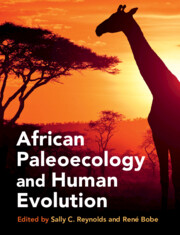Book contents
- African Paleoecology and Human Evolution
- African Paleoecology and Human Evolution
- Copyright page
- Dedication
- Contents
- Contributors
- Acknowledgments
- Part I Modern Africa and Overview of Late Cenozoic Paleoenvironments
- 1 Introduction: African Paleoecology and Human Evolution
- 2 Approaches to the Study of Past Environments
- 3 Environmental and Stratigraphic Bias in the Hominin Fossil Record
- 4 Late Miocene and Earliest Pliocene Paleoecology of Africa
- 5 The Middle Pleistocene Through the Holocene of Africa
- Part II Southern Africa
- Part III Eastern and Central Africa
- Part IV Northern Africa
- Volume References
- Index
- Plate Section (PDF Only)
3 - Environmental and Stratigraphic Bias in the Hominin Fossil Record
Implications for Theories of the Climatic Forcing of Human Evolution
from Part I - Modern Africa and Overview of Late Cenozoic Paleoenvironments
Published online by Cambridge University Press: 19 May 2022
- African Paleoecology and Human Evolution
- African Paleoecology and Human Evolution
- Copyright page
- Dedication
- Contents
- Contributors
- Acknowledgments
- Part I Modern Africa and Overview of Late Cenozoic Paleoenvironments
- 1 Introduction: African Paleoecology and Human Evolution
- 2 Approaches to the Study of Past Environments
- 3 Environmental and Stratigraphic Bias in the Hominin Fossil Record
- 4 Late Miocene and Earliest Pliocene Paleoecology of Africa
- 5 The Middle Pleistocene Through the Holocene of Africa
- Part II Southern Africa
- Part III Eastern and Central Africa
- Part IV Northern Africa
- Volume References
- Index
- Plate Section (PDF Only)
Summary
Comparisons between the hominin or Neogene mammal fossil record and contemporaneous paleoclimate proxies have been commonplace since the pioneering studies of Elisabeth Vrba (1980, 1992, 1995a, 1995b). Vrba combined the new macroevolutionary theories of punctuated equilibrium and species selection (e.g., Eldredge and Gould, 1972; Vrba, 1985b) with emerging evidence for global climate change in the Plio-Pleistocene (e.g., Shackleton et al., 1990) to produce testable hypotheses of faunal turnover pulses in the Neogene fossil record. Vrba focused her analyses on the speciose Neogene bovids, rather than hominins, to ensure statistically robust results. Periods of bovid, and by inference hominin, turnover (origination, extinction and migration) between 2.8 and 2.5 Ma and at ~1.8 Ma were linked to episodes of global cooling seen in the global stable isotope records (Vrba, 1995b). Behrensmeyer et al. (1997) argued that Vrba’s turnover pulses were predominantly a product of sampling bias, by showing that bovid diversity and the number of bovid-bearing localities covaried. A study by deMenocal (1995) was the first to take Vrba’s hypothesis a step further by replacing the bovid fossil record with the hominin fossil record and suggesting that African aridity was behind the evolution of early Homo at approximately 2.0 Ma. This study took the hominin fossil record at face value despite its far greater incompleteness relative to the bovids, paving the way for a new wave of paleoclimatic theories. Potts (1996, 1998a, 1998b) took the debate further from Vrba’s original approach by dispensing with the notion of a shared climatic forcing between hominins and other mammals and proposed the Variability Selection (VS) hypothesis. The VS hypothesis is formulated around the idea that early hominins evolved unique adaptions for ecological versatility in response to climatic variability, so the fossil record of other mammal groups cannot be used to falsify the hypothesis. More recent iterations of the VS hypothesis (such as Maslin and Trauth, 2009; Shultz and Maslin, 2013; Maslin et al., 2014) also rely exclusively on the hominin fossil record as the explicit test case for their hypothesis.
- Type
- Chapter
- Information
- African Paleoecology and Human Evolution , pp. 15 - 23Publisher: Cambridge University PressPrint publication year: 2022
- 1
- Cited by



